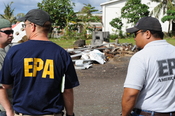Outline the development of the theory of environmental racism. How useful
is this theory outside the US context?
Abbreviations used:
LULU's: Locally undesirable land uses
EPA: U.S Environmental Protection Agency
TSDF: Treatment, storage and disposal facilities
UCC: United Church of Christ Commission
U.S: United States of America
Establishing whether environmental racism exists or not has been the cause of much debate. As the theory develops it is met with more and more criticism. Evaluating the consequences of significant criticisms is essential to form a better understanding of its development. This clearer understanding could aid speculation in establishing whether the theory is applicable outside the U.S or not.
Despite not being officially coined until 1987, the idea of environmental racism has been imbedded within politics since the 1800's. People of color have attempted to improve the housing conditions of slaves, fought for the right to buy land and generally struggled to improve their situation within racist America.
Opposition to public and residential segregation with boycotts emerged during the 1940's, 50's and 60's, and more recently demonstrations against pesticide poisoning and noxious facilities in the 1980's. This increase in the participation of people of color in environmental activism acted as a spark and can be considered to have contributed to the formation, as a backdrop, for the creation of the environmental racism theory. By drawing attention through various demonstrations environmental activists caused scholars and policy makers to investigate the link between race and exposure to environmental hazards. Thus, it has been argued that this raise in awareness of environmental hazards acted as a "frame" for the creation of the environmental racism theory and movement. (Taylor, 2000).
Two primordial studies exposing the link between race and exposure to environmental hazards can be credited for creating environmental racism as a theory. The US GAO...


